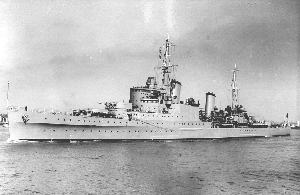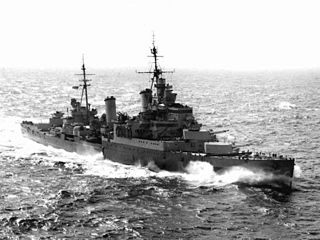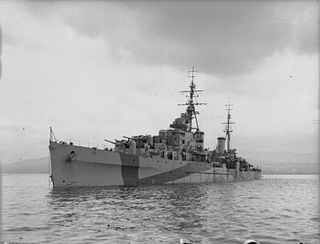
HMNZS Achilles was a Leander-class light cruiser, the second of five in the class. She served in the Royal New Zealand Navy in the Second World War. She was launched in 1931 for the Royal Navy, loaned to New Zealand in 1936 and transferred to the new Royal New Zealand Navy in 1941. She became famous for her part in the Battle of the River Plate, alongside HMS Ajax and HMS Exeter and notable for being the first Royal Navy cruiser to have fire control radar, with the installation of the New Zealand-made SS1 fire-control radar in June 1940.

HMS Kenya was a Fiji-class cruiser of the Royal Navy. The ship was named after Kenya, a British possession at the time of the ship's construction.

HMS Mauritius, pennant C80, was a Fiji-class light cruiser of the Royal Navy. The ship was built by Swan Hunter, Newcastle upon Tyne. She was named after Mauritius, which was a British colony when she was built and entered service in 1941.

HMS Glasgow was a Town-class cruiser commissioned in September 1937. She took part in the Fleet Air Arm raid that crippled the Italian Fleet at Taranto in 1940. She had the unfortunate experience of sinking two Allied ships during her wartime service, once through accidental collision and the other by gunfire after a case of mistaken identity.

The Dido class consisted of sixteen light cruisers built for the Royal Navy during World War II. The first group of three ships were commissioned in 1940; the second group of six ships and third group of two were commissioned between 1941 and 1942. A fourth group, also described as the Improved Dido or Bellona class were commissioned between 1943 and 1944. Most members of the class were given names drawn from classical history and legend. The groups differed in armament, and for the Bellonas, in function. The Dido class were designed as small trade protection cruisers with a secondary role in the battlefleet as large destroyer leaders. As designed, they mounted five twin 5.25" high-angle gun turrets on the centreline providing dual-purpose anti-air and anti-surface capacity; the complex new turrets were unreliable when introduced, and somewhat unsatisfactory at a time when the UK faced a fight for survival. During the war, the original 1939-42 ships required extensive refit work to increase electrical generating capacity for additional wartime systems and in the final Bellona,HMS Diadem, fully-electric turrets. While some damage was experienced initially in extreme North Atlantic weather, changes to gun handling and drill partially mitigated the problems. The fitting of the three forward turrets in the double-superfiring A-B-C arrangement relied upon the heavy use of aluminium in the ships' superstructure, and the lack of aluminium after the Dunkirk Evacuation was one of the primary reasons for the first group only receiving four turrets, while the third group received four twin 4.5" mounts and no 5.25" guns at all. The Bellonas were designed from the start with four radar-directed 5.25" gun turrets with full Remote Power Control and an expanded light anti-aircraft battery, substantially increasing their efficiency as AA platforms.

HMS Euryalus was a Dido-class cruiser of the Royal Navy. She was laid down at Chatham Dockyard on 21 October 1937, launched on 6 June 1939, and commissioned 30 June 1941. Euryalus was the last cruiser built at the dockyard.

HMS Sheffield was one of the Southampton sub class of the Town-class cruisers of the Royal Navy during the Second World War. She took part in actions against several major German warships. Unlike most Royal Navy ships of her time, her fittings were constructed from stainless steel instead of the more traditional brass. This was an attempt to reduce the amount of cleaning required on the part of the crew. Her nickname, the "Shiny Sheff", stemmed from this. A prototype radar system was placed into service in August 1938 on the Sheffield. It was the first vessel in the Royal Navy to be so equipped.

HMS Argonaut was a Dido-class cruiser of the British Royal Navy which saw active service during the Second World War. Constructed at the Cammell Laird shipyard, Birkenhead, Argonaut was laid down in 1939, launched in September 1941, and formally commissioned into service on 8 August 1942.

HMS Bellona was the name ship of her sub-class of light cruisers for the Royal Navy. She was the first of the fourth group of Dido-class cruisers. Built to a modified design with only four twin 5.25-inch turrets, but with remote power control for quicker elevation and training, combined with improved handling and storage of the ammunition. The light AA was improved over earlier Dido cruisers, with six twin 20mm Oerlikons and three quadruple 40mm "pom pom".

HMS Charybdis was a Dido-class cruiser built for the Royal Navy during the Second World War and was sunk with heavy loss of life by German torpedo boats in an action in the English Channel in October 1943.

HMS Cleopatra was a Dido-class cruiser of the Royal Navy. She was built by R. and W. Hawthorn, Leslie and Company, Limited, with the keel being laid down on 5 January 1939. She was launched on 27 March 1940, and commissioned on 5 December 1941.

HMS Diadem was a Dido-class light cruiser of the Bellona subgroup of the Royal Navy. She was a modified Dido design with only four turrets but improved anti-aircraft armament – also known as Dido Group 2. She was built by Hawthorn Leslie and Company at Hebburn-on-Tyne, UK, with the keel being laid down on 15 December 1939. She was launched on 26 August 1942, and completed on 6 January 1944.

HMS Dido was the name ship of her class of light cruisers for the Royal Navy. Constructed by Cammell Laird Shipyard of Birkenhead, United Kingdom, she entered service in 1940 during World War II. The cruiser took part in several battles in the Mediterranean and Arctic theatres of war. Following the war, the ship performed ceremonial functions before being sold for scrapping in 1957.

HMS Berwick, pennant number 65, was a County-class heavy cruiser of the British Royal Navy, part of the Kent subclass. She was built by Fairfield Shipbuilding and Engineering Company, Govan, Scotland, with the keel being laid down on 15 September 1924. She was launched on 30 March 1926 and commissioned 12 July 1927. When completed, Berwick was sent to the China Station, where she remained until a temporary detachment to the Mediterranean in 1936. Along with the rest of her Kent class sub-group of County-class ships, Berwick underwent reconstruction between 1937 and 1938, where her single 4-inch guns were replaced with double mounts, numerous light machine guns were added, along with a significant addition of note; a cemented 4-inch (100 mm) thick and 6 feet (1.8 m) deep armoured belt was added to both sides of her hull beginning at the armoured deck down past her water line.

HMS Naiad was a Dido-class light cruiser of the Royal Navy which served in the Second World War. She was sunk in action on 11 March 1942 south of Crete in the Mediterranean Sea.

HMS Sirius was a Dido-class light cruiser of the Royal Navy. She was built by Portsmouth Dockyard, with the keel being laid down on 6 April 1938. She was launched on 18 September 1940, and commissioned 6 May 1942.

HMS Gambia was a Fiji-class light cruiser of the Royal Navy. She was in the service of the Royal New Zealand Navy (RNZN) as HMNZS Gambia from 1943 to 1946. She was named after the then Crown colony of the Gambia, and has been the only ship of the Royal Navy to bear the name.

HMS Martin was an M-class destroyer of the Royal Navy, launched at the Tyneside yard of Vickers-Armstrongs on 12 December 1940. She had a busy but brief wartime career, being sunk by the German submarine U-431 on 10 November 1942 off Algiers.

The destroyer HNLMS Tjerk Hiddes was a British built, Dutch warship of World War II. She was laid down on 22 May 1940 as a British N-class destroyer and launched on 25 June 1941 as HMS Nonpareil, but on 27 May 1942, she was transferred to the Royal Dutch Navy. The ship was commissioned in 1942 as HNLMS Tjerk Hiddes, named after the 17th century Dutch admiral, Tjerk Hiddes de Vries. Much of her war service was with the Royal Navy and United States Navy in the Indian Ocean and Australia. Following the war, the destroyer was sold to Indonesia and renamed RI Gadjah Mada. She was scrapped in 1961.

The German torpedo boat T22 was one of fifteen Type 39 torpedo boats built for the Kriegsmarine during World War II. Completed in early 1942, the ship was transferred to France later that year where she escorted blockade runners and Axis submarines through the Bay of Biscay. T22 also laid minefields in the English Channel in mid-1943. She participated in the Battle of Sept-Îles, where she crippled a British destroyer, and the Battle of the Bay of Biscay later that year. After returning to Germany in early 1944, T22 struck a pair of mines in Narva Bay in August and blew up, with the loss of 143 men.





















